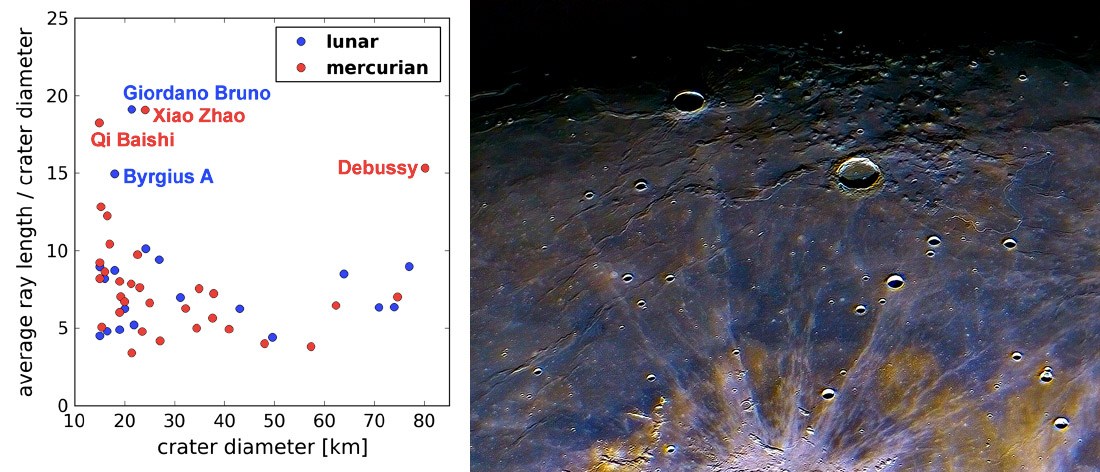January 9, 2014
How Long Are Rays?

diagram from Braden and Robinson (2013); Kepler ray enhanced color image by Maximilian Teodorescu, Cota 1000 (SInaia), Romania
The Messenger spacecraft in orbit around Mercury is providing vast amounts of data on another lunar-like world. One of the interesting byproducts is comparison with our Moon. Although volcanism and impact craters occurred on both worlds things might be different on Mercury because of its higher gravitational acceleration, higher impact velocities, different composition and other things we aren't yet aware of. The chart on the left from recent work of LRO scientists Sarah Braden and Mark Robinson shows something that is essentially the same for the Moon and Mercury. At first it seems counter-intuitive that the length of crater rays (compared to the diameters of craters that formed with them) would be the same. But the authors explain that the higher gravity of Mercury, which would reduce the distance rays would be ejected, is counter-balanced by the greater average impact velocity which would throw ejecta further. So the red dots (Mercury) and the blue ones (Moon) seem to follow the same trends. For the Moon, rays extend on average 8 (plus or minus 4) times the diameter of the crater that formed them. For a 50 km diameter crater, rays should be about 400 km long. Two lunar craters have considerably longer rays than the other craters. Byrgius A has rays about 15 times as long as its crater diameter, and Giordano Bruno's rays extend 20 times its diameter. Rays from both of these craters are less mature (haven't been darkened by space weathering as much) as the other rayed craters, so these are younger craters. The shorter rays for the somewhat older craters, and no rays for even older craters, demonstrate that rays are eroded away with time. In fact, probably all craters originally had rays 15-20 times their diameter. If we apply any of these ray-to-crater diameter ratios to impact basins we see that their rays would have travelled much further than the Moon's diameter. The Earth was rayed by the Moon (and vice-versa) 4 billion years ago.
Chuck Wood
Technical Details
Image: December 13, 2013, 20:23-21:15 U.T. C11@F/10 with ASI120MM (plus IR-pass filter) for details, and Canon 550D for color. The full mosaic - seen here - is composed of 52 images each a 500-frame stack. The color data was extracted from 13 images, each a 30-frame stack. Seeing 3/10.
Related Links
21st Century Atlas chart 22.
Sarah E. Braden and Mark S. Robinson (2013) Relative rates of optical maturation of regolith on Mercury and the Moon. Journal of Geophysical Research - Planets 118, 1903–1914.
Yesterday's LPOD: Mount Molar
Tomorrow's LPOD: Eating a Smaller Fry
COMMENTS?
Register, Log in, and join in the comments.



